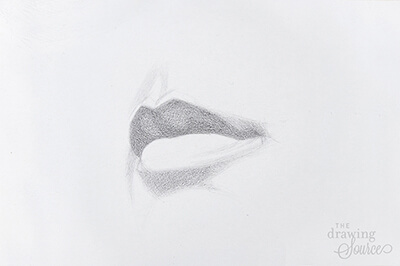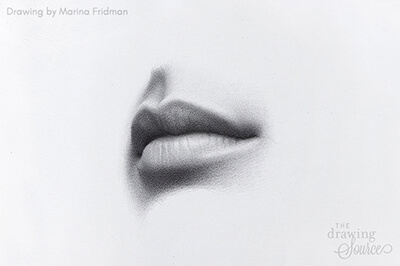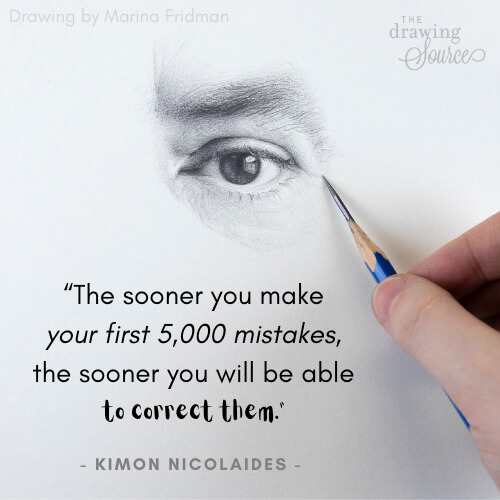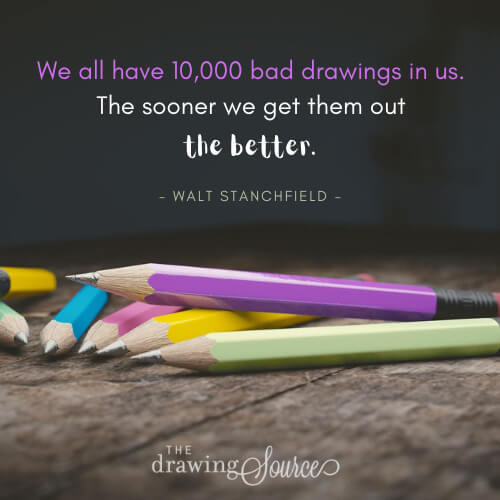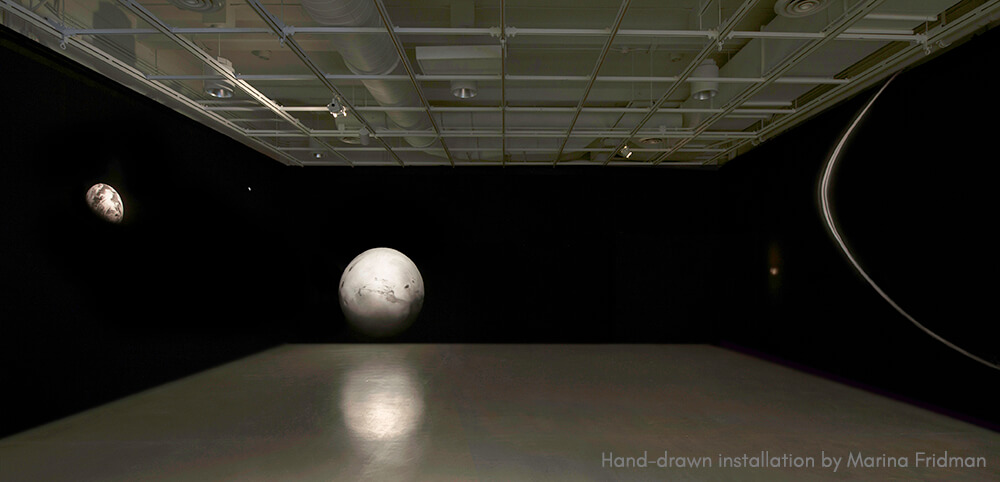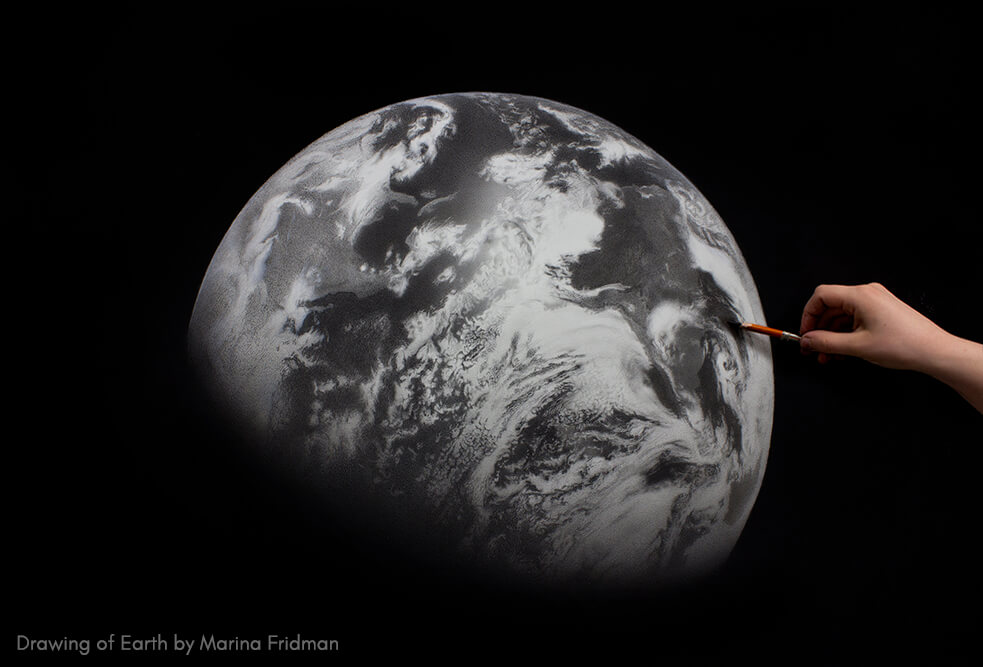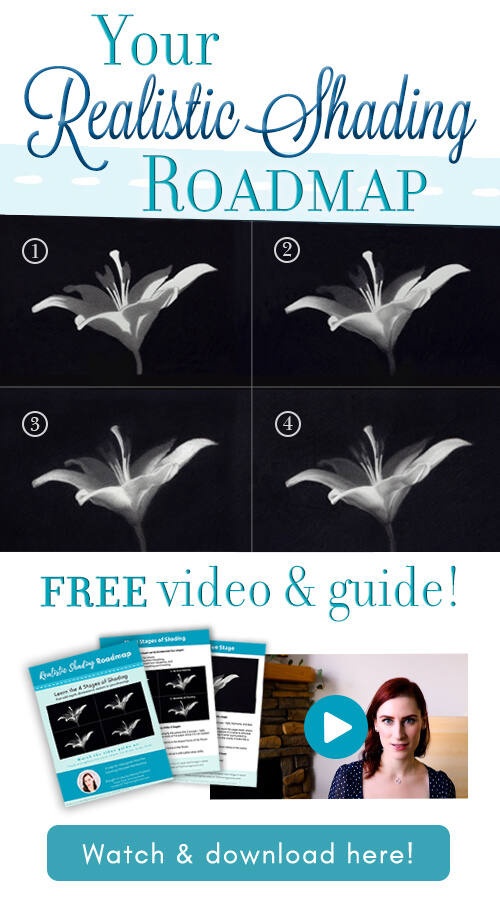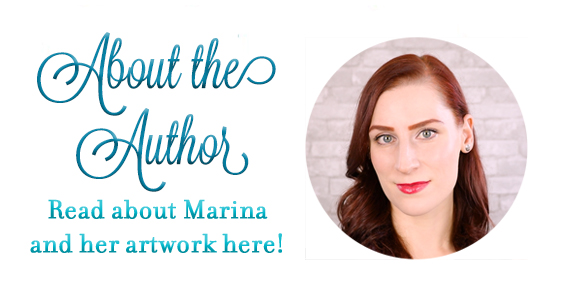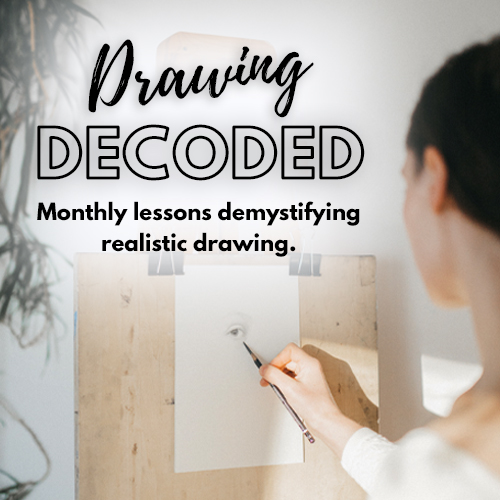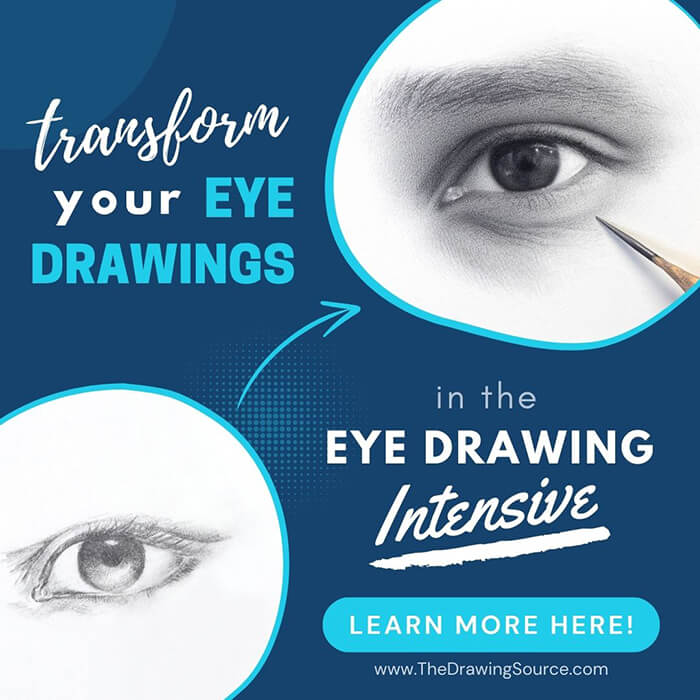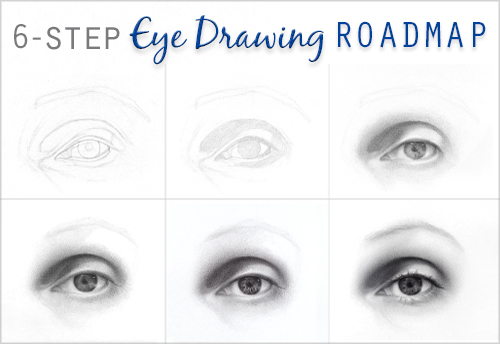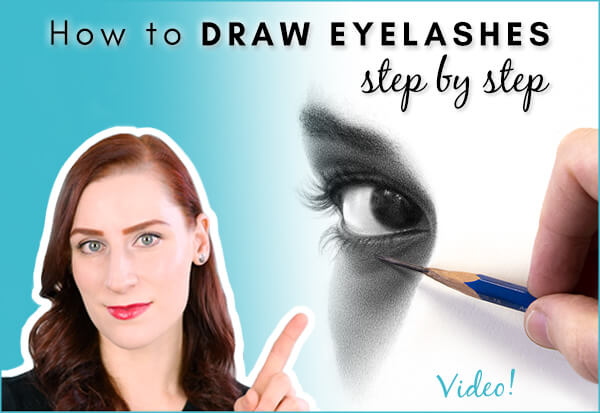- Home
- Inspirational Drawings
- Artistic Frustration
9 Ways to Overcome Artistic Frustration and Perfectionism when Learning to Draw
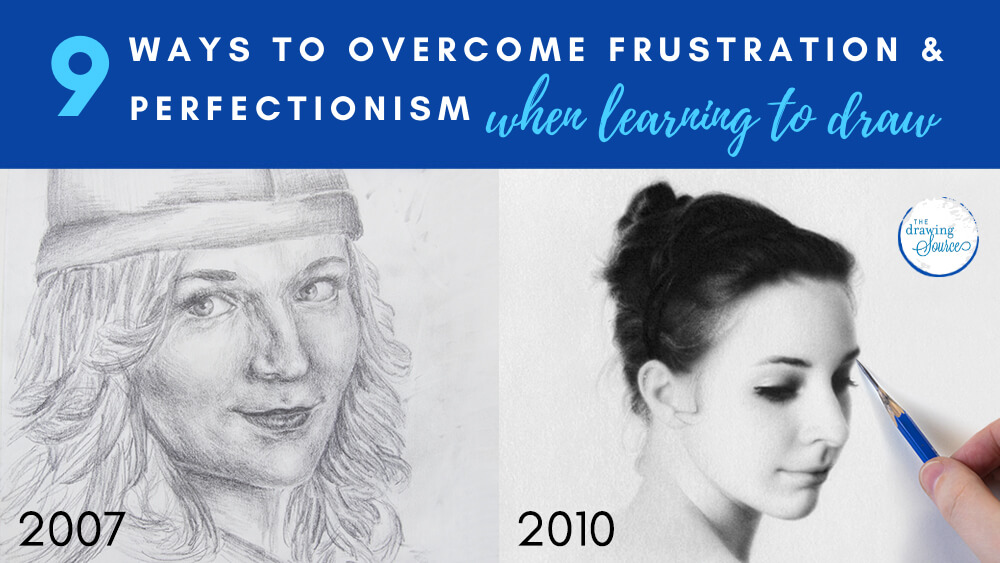
If you have ever experienced artistic frustration while drawing (or wondered in exasperation, “Can I actually learn to draw?") then this article is for you.
Why do we decide to learn a new skill or pick up a new hobby? Because we expect to enjoy it, right? (There can certainly be other reasons, such as a sense of pride or accomplishment, but we rarely start something we think we will hate!)
Once we
start studying or practicing, however, we quickly realize how much work lies ahead in order to become proficient. All too often, this leads to self-imposed pressure, time limits, or unrealistic goals, all of which can prevent our full enjoyment of the activity. Unfortunately, enthusiasm can quickly turn to frustration. Why does this happen, and what can we do about it?
Our character traits can help us or hinder us in the learning process (usually a bit of both!) Perfectionism, for example, is a double-edged sword. It can push us to strive for new heights, or cause us to freeze, unable to take the next step for fear of 'getting it wrong'.
I write this article as someone who has long observed these tendencies in myself. I can be both impatient and something of a perfectionist - a combination that can wreak havoc if I allow it to. This has made me something of a ‘mindset enthusiast,’ and over the years I have discovered processes to lessen the artistic frustration that can arise when our drawings (or drawing processes) aren’t progressing the way we had envisioned.
I have observed
that the more we allow ourselves to enjoy the drawing process, the faster we
progress. Because this is often easier said than done, in this guide I share 9 processes that I find most helpful in easing artistic frustration and allowing oneself to enjoy everything
that comes with learning to draw.
The following strategies are from my Mindset Minutes course in the Drawing Decoded Membership.
Table of Contents
Strategy 1: Adopt a new perspective on the drawing process
Strategy 1 Exercise
Strategy 2: Find the parts of the drawing process that you love
Strategy 2 Exercise
Strategy 3: Focus on 'small wins,' or one step at a time
Strategy 3 Exercise
Strategy 4: Notice how much you have already learned and improved
Strategy 4 Exercise
My drawing improvement "before and after" photos
Strategy 5: Practice drawing in ways that relieve perfectionism
Strategy 5 Exercise A
Strategy 5 Exercise B
Strategy 6: Understand how drawing practice accumulates
Strategy 6 Exercise
Strategy 7: Rewrite limiting thoughts
Strategy 7 Exercise
Strategy 8: Let go of unrealistic goal-setting
Strategy 8 Exercise
Strategy 9: Take a break
Strategy 9 Exercise
Artistic Frustration vs. Enjoyment of the Process
Overcoming Artistic Frustration - STRATEGY 1:
Adopt a new perspective on the drawing process
We can distill
the drawing process into three main categories:
A) Noticing areas
of your drawing that don’t look like your subject
B) Analyzing why they don’t look like your subject
C) Taking steps to make them look more like your subject
D) Repeating steps A through C
Do you notice that the word ‘mistake’ is nowhere to be found in the above statement? A mistake implies that something has gone wrong, when really – nothing has gone wrong! If your drawing does not yet resemble your subject, it’s simply a ‘Step A’ moment, a natural part of the drawing process.
Knowing this, you can expect that for most of the process, your drawing will not convincingly resemble your subject. You haven’t failed! You’re simply not finished yet. Keep going.
With practice, experience, and proper instruction, you will move through the stages of the drawing process more quickly, efficiently, and with more confidence, arriving sooner at a convincing drawing. However, the process will always be one of exploration, discovery and revision.
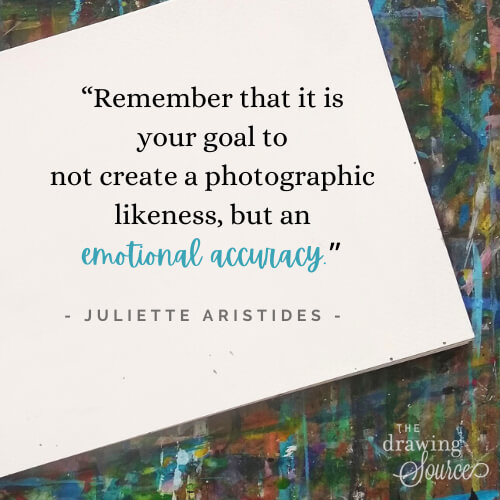
“Remember that it is your
goal to not create a photographic likeness, but an emotional accuracy.”
-Juliette Aristides-
My drawings tend
to go through an 'ugly duckling phase'. Would you imagine, looking at the drawing
below on the left, that it would become the drawing on the right? Well, it did in this lip drawing tutorial! Was the drawing 'wrong' or 'incorrect' because it didn't resemble my subject for the first while? Not at all, it was simply in an early (and necessary) stage of the drawing process.
When your drawing does not yet look like your subject, give yourself a break! Try to relax into the
process rather than interpreting it as something 'gone wrong'.
Since learning how to see is an essential part of drawing, whenever you notice a specific difference between your drawing and
your subject - celebrate! This is evidence that your eye is improving and that you are becoming a more
sensitive observer.
Strategy 1 Exercise:
As you draw, remind yourself that when your drawing doesn’t look like your subject, nothing has gone wrong: it’s simply not finished yet.
Every time you notice a discrepancy between your drawing and your subject (a "Step A" moment, previously known as a "mistake”) - smile! It is proof that your eye is improving and that you are becoming a more sensitive observer.
Overcoming Artistic Frustration - STRATEGY 2:
Accept that learning to draw will take
time and practice. Find and focus on the parts of the process that you love!
Drawing is a
multi-faceted skill that takes time and practice to acquire. There is no way
around this. You simply won’t learn to draw masterfully in a day, a week, or
even several months (though you can make significant progress in that time with
proper instruction and practice!)
However, if we consciously bring our attention to the parts of the drawing process that we most enjoy, it can ease our rush to get to a certain skill level, or to the end result of a drawing.
The key is to find the parts of the process that you most enjoy. For example, do you enjoy ...
- The attentive
observation that allows you to discover new worlds within a subject that you
previously considered “ordinary”?
- That when you draw, you’re essentially using a burnt twig to arrange dust on paper in a way that creates
a believable, realistic image? (If that's not magic, I don't know what is!)
- The sensation of
your hand moving across the page? The smoothness with which your pencil leaves
marks on your paper?
- That the more you
draw, the more it becomes a part of your identity, and you start perceiving yourself as an artist?
- The challenging
nature of this activity and that you are practicing it anyway? (Not everyone does!)
- Being in your studio space? (Even if your studio is a corner of your living room!)
There is so much to enjoy on your way to a finished drawing! These are just a few of the possible examples.
Strategy 2 Exercise:
Take a few minutes to consider what you enjoy about drawing, other than the finished product. This can be anything! The important thing is that it resonates with you, and that you can focus on it and return to it in moments of artistic frustration. If you can come up with several enjoyable aspects – even better. If you like, you can write them out and read them when you need a boost of confidence as you draw.
Enjoying these processes? They are from the Mindset Minutes course in the Drawing Decoded Membership!
Overcoming Artistic Frustration - STRATEGY 3:
Focus on 'small wins', or one step at a time
You don’t need to
foresee all the steps you will need to take to finish your drawing. You just need the
next, easiest step. Focusing on the next small step forward can reduce
anxiety and artistic frustration, helping you to enjoy the drawing process.
(It can also greatly
help to know what stage of the drawing process you’re in and what the
priorities of that stage are. You can learn these in my free Mini-Course.)
Strategy 3 Exercise:
As you draw, ask yourself: What is the next easiest step? What one small step can I take right now and feel accomplished in? (If it’s a single mark, that’s okay!)
What would make the next step fun? (No, I don’t mean opening a bottle of wine! In other words, what small step in your drawing would you enjoy taking next?)
Overcoming Artistic Frustration - STRATEGY 4:
Focus on what you have already learned and on how much you have improved
Have you been
drawing for a while? Have you ever stopped to reflect on how much you have
already learned and improved?
All too often we speed
past our accomplishments, when the simple act of acknowledging them can improve
our mood and our confidence, motivating us to continue.
Strategy 4 Exercise:
Take 15 minutes or so to look through your older drawings (your earliest ones, if you have them!) Compare them to your more recent drawings. List all the ways in which you have improved, and consider all the knowledge and skill that you have acquired.
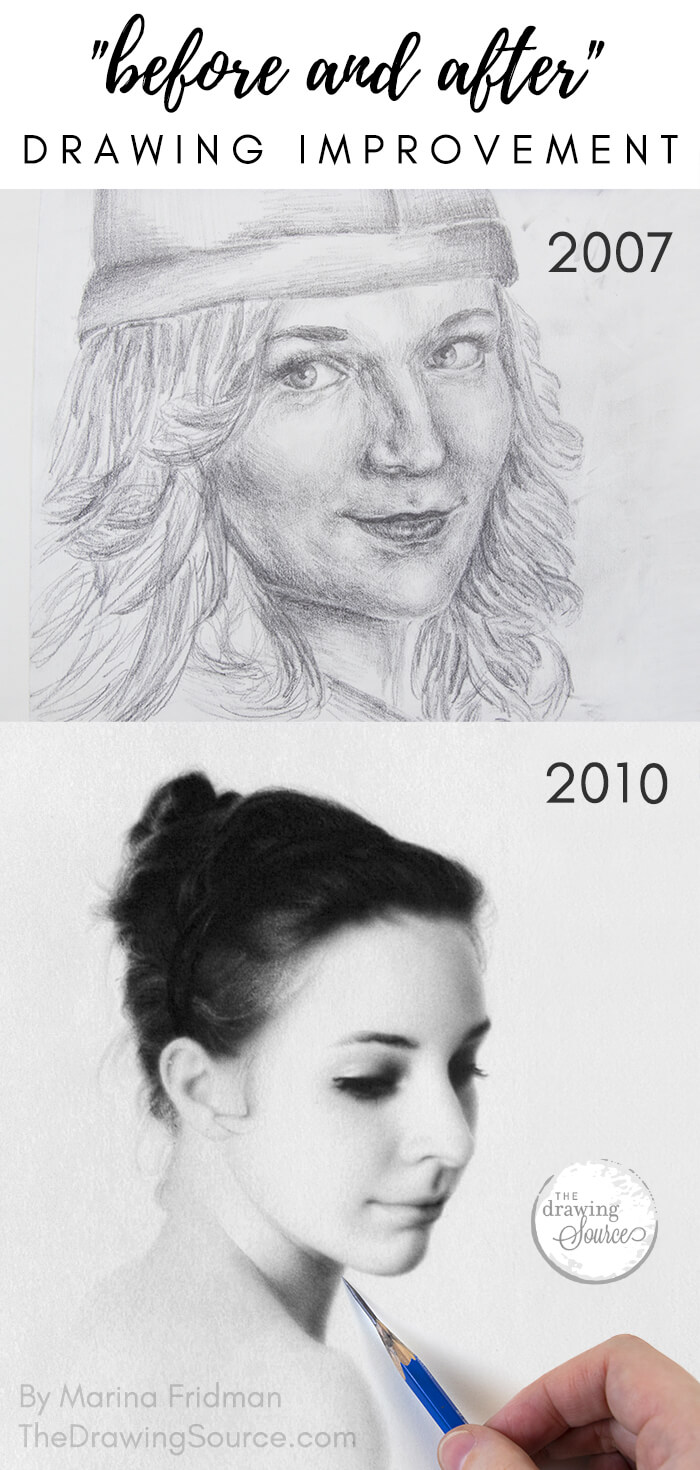
I decided to do this exercise as well, and show you a comparison of two early portrait drawings. In the image above, the top photo is an early self-portrait that I drew in 2007 before beginning my full-time art education. (Though it's not my first portrait, nor my 'worst' one, it is the earliest one I could find.) I completed the bottom portrait a year or two into my full-time art studies. (You can read about my drawing studies, and view more early works in this article.)
These days I create gallery-sized drawings, such as the drawing of outer space below.
(You can read more about this artwork here.)
I show you this to point out that I was not born with an innate ability to draw! It has taken years of study and practice, and it all began with seeking out the drawing education that I needed, and committing to a life-long journey of study and improvement.
I invite you to do the same by taking my free Mini-Course on the essential concepts and stages of realistic drawing (or jump into my entire curriculum here!)
Enjoying these processes? They are from the Mindset Minutes course in the Drawing Decoded Membership!
Overcoming Artistic Frustration - STRATEGY 5:
Practice drawing in a way that relieves the pressure of perfectionism
Try these ways of
tricking yourself into relieving the pressure of perfectionism and having more
fun while you draw:
Strategy 5 Exercise A) Practice short, repetitive drawing exercises (I introduce many in my Drawing Decoded Membership). Many of the most useful drawing exercises don’t lead to a beautiful, finished product. Instead, they isolate a specific skill or part of the drawing process, and are intended to be completed fairly quickly, and in great number. After all, repetition is the mother of skill.
Much of drawing
requires us to get a certain amount of general information on the page before
we can effectively judge whether or not it’s accurate. Examples of this are
using the envelope method to start a drawing, or
simplifying the values of a subject into three groups. (You can learn both of these skills, and more, in my Drawing Decoded Membership.)
Short drawing exercises are an excellent way to greatly improve your skills, and to get used to pushing
through ‘perfectionism paralysis.’ Practicing in this way can lessen the 'preciousness' with which we often
approach drawings, helping us get information on
the page quickly before refining and revising it. (After all, you can't
perfect what's not there!)
Strategy 5 Exercise B) Start a new drawing. Tell yourself that it’s a ‘throwaway’, or that it’s just for fun. Nothing serious happening here. Give yourself a time frame (less time than it would take you to finish the drawing), and draw for the enjoyment of the process only.
Overcoming Artistic Frustration - STRATEGY 6:
Remember that hours of drawing practice accumulate and compound
As you practice
drawing, it’s natural to want to see clear, measurable improvement. However, it’s
important to keep in mind that progress is often not linear.
In the book Atomic Habits, author James Clear gives one of my favorite examples of what progress looks like. He uses the example of melting an ice cube in a room heated to 25 degrees Fahrenheit. He describes the temperature of the room rising … to 27 degrees … to 29 degrees … with no visible change to the ice cube. At 31 degrees – still nothing.
Then, at 32 degrees, finally the ice begins to melt.
Would this have been possible without the time and energy that raised the temperature of the room to 32 degrees? Absolutely not!
"Breakthrough moments are often the result of many previous actions, which build up the potential required to unleash a major change," writes Clear. The issue is that, “People make a few small changes, fail to see a tangible result, and decide to stop.” Though Clear is referring to developing good habits here, this applies perfectly to drawing.
When learning to draw, you may only see significant results when you hit a similar ‘32 degree threshold’, but it won’t be possible without all of the work you put in prior to that. Clear calls the time period where you don’t see significant improvement the “plateau of latent potential,” or the “valley of disappointment,” explaining that it’s a hallmark of the compounding process.
To make a meaningful difference in your drawing skills, the work you put in needs to accumulate long enough to break through inevitable plateaus. What seems like a stagnant period does not mean that the work you’re doing isn’t having an effect.
I highly recommend the book Atomic Habits, and listen to it regularly to remind myself that it’s the accumulation of small, daily actions that create tangible results.
What does this mean for your drawing skills?
It means that all drawing practice accumulates (no matter how the drawing turns out!), eventually resulting in undeniable improvement. Worst case scenario: what if you don’t like your finished drawing? You have still successfully added to the hours of practice necessary to eventually overcome the “plateau of latent potential.”
You can bask in the knowledge that drawing practice is never wasted time, never failure. You’re completing the one essential action for improvement: practicing and learning.
Every time you draw, you succeed in accumulating the experience necessary for improvement.
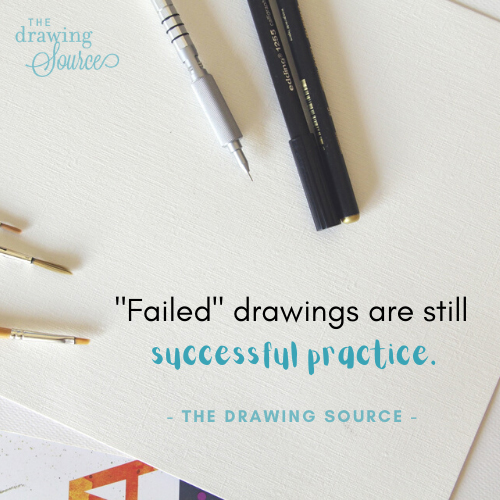 "Failed drawings" are still successful practice.
"Failed drawings" are still successful practice.Strategy 6 Exercise:
When you find yourself in a period of seemingly stagnant growth, remember that the most powerful outcomes are delayed.
Every time you draw, no matter the outcome of the drawing, you accumulate experience that will eventually result in massive, undeniable improvement. You are in a time of latent progress, just like the melting ice cube from the earlier example.
“Complaining about not achieving success despite working hard is like complaining about an ice cube not melting when you heated it from 25 to 31 degrees. All the action happens at 32 degrees.” -James Clear, Atomic Habits
Enjoying these processes? They are from the Mindset Minutes course in the Drawing Decoded Membership!
Overcoming Artistic Frustration - STRATEGY 7:
Rewrite limiting thoughts
Do you ever notice how often you think repetitive thoughts? Our minds constantly return to
thoughts that we had the day before, the day before that, etc.
When these repetitive thoughts are negative, if left unchecked they can become ingrained beliefs that restrict our progress and development. For example, if you repeatedly think, “I’ll never learn to draw,” could this hinder your progress and happiness, eventually becoming a belief that causes you to stop drawing? Certainly.
Fortunately, through conscious effort we can learn to catch ourselves when we think unproductive thoughts, and, one by one, rewrite our own scripts.
The key here is to notice yourself thinking a negative thought, and to reach for a slightly better-feeling thought.
For example, the thought, “This drawing looks terrible,” can be replaced with, “My drawing isn’t looking like my subject yet, but I know that this is a natural part of the drawing process. With practice I’ll be able to move through the steps of the drawing process more easily and effectively. My next step is to analyze why my drawing isn’t resembling my subject.”
An important point is that this slightly better-feeling thought needs to be believable. For example, trying to replace the thought, “I’ll never learn how to draw,” with “I’m a brilliant draftsperson,” probably won’t work. Instead of taking such a drastic leap, reach for something that you can believe right now, and that feels better.
For example, try replacing, “I’ll never learn how to draw,” with: “I know that learning to draw takes time and cumulative practice. I drew for an hour today, practicing using exercises from a qualified teacher. My skills are improving every day, even if the visible progress is slight. If I continue practicing, I will inevitably improve.”
Doesn’t that feel better?
Since I started using this technique daily, I have noticed a tremendous improvement in my mood, and more enjoyment in all of my activities, not just drawing.
Strategy 7 Exercise:
On a piece of paper, draw two columns. Title the left one "Limiting Thoughts", and the right one "Better-Feeling Thoughts". As you draw, notice any limiting or negative thoughts that arise, and write them down.
What slightly better-feeling thoughts can you replace them with? Write down each better-feeling thought in the right column, across from the limiting one that it’s replacing.
As you continue drawing, every time that limiting thought arises, consciously replace it with your better-feeling thought.
Overcoming Artistic Frustration - STRATEGY 8:
Let go of unrealistic goal setting.
Focus on growth rather than an end goal.
I am an avid
goal-setter. I love having a clear idea of what I want to accomplish, and in what
time frame. However, after years of goal-setting I noticed an unhealthy pattern:
I constantly underestimated the time it would take to finish or achieve
something. (And not by a little bit: by at least two thirds!) Then, when I
didn’t achieve said goal in that unrealistic time frame, I felt like a failure.
Once I realized this (after years of unrealistic goal setting!), I tried tripling the amount of time that I allowed myself to accomplish any given task. That helped to some degree, but still wasn’t quite the answer I was looking for.
If you’re reading this account and thinking, “Why on Earth would anyone put themselves through this,” then feel free to skip ahead, and consider yourself one of the lucky ones to whom this doesn’t apply!
If this resonates
with you, let’s pause this story to consider how silly it is to give ourselves
a time limit to improve or achieve something (especially a challenging skill
that you’re learning such as drawing).
When a child is learning how to walk, do we give them a time limit?
“You better be walking by August 13, Jimmy!”
No, that’s absurd! Does that child stop trying to learn how to walk if they haven’t been able to by a certain day? Of course not.
How do we respond to their process of learning how to walk? We support that child for as long as it takes, without question, celebrating the smallest signs of progress.
What if we adopted that same attitude towards ourselves: supporting ourselves without question for as long as it takes to learn or achieve whatever we’re striving for, excitedly celebrating the smallest milestones that we achieve along the way? Wouldn’t that transform our experience?
After trying more realistic goal setting for some time, I came across James Clear’s Atomic Habits book, and tried something completely foreign to me: I let go of goal-setting for a while, and instead adopted Clear’s attitude of focusing on daily, minuscule, 1% improvements rather than an end result.
“Forget about goals, focus on systems instead,” writes Clear, pointing out that focusing on the daily action necessary to achieve a result still gets you to the goal!
I felt significant relief when the concepts of this book “clicked”. With this mindset shift, I started feeling accomplished every day, and found that this works phenomenally for drawing. After all, I am still, and will always be, improving my drawing skills. In that sense, there is no possible ‘end’ to get to, so I might as well enjoy the journey!
Strategy 8 Exercise:
Try setting an easily-achievable, ‘progress-focused’ goal. For example, to practice drawing for 10 minutes per day for the next week (adjust as needed for your situation).
As you progress, you can set more complex, specific, or ambitious goals, but the aim here is for you to feel great about the process of learning how to draw, starting today.
Enjoying these processes? They are from the Mindset Minutes course in the Drawing Decoded Membership!
Overcoming Artistic Frustration - STRATEGY 9:
Take a break
Sometimes the
best thing to do is to take a break from your drawing. Frustration can build up
momentum that can be difficult to escape, and a way to slow it down is to shift
your attention to something else entirely.
If the resistance is too great to be helped by any of the previous techniques, it can be a sign that you need to walk away for a while.
When this
happens, remind yourself that taking breaks from your drawing is an excellent
habit to establish, because it allows you to view it from a
fresh perspective when you return to it again.
Strategy 9 Exercise:
The next time you feel the momentum of artistic frustration build, ask yourself: Does this feel like a good time to take a break? Would I feel relief if I walked away from my drawing right now?
If yes – do it! (And even if not, turn away from your drawing for a few minutes just so you can view it and your subject matter with a fresher perspective!)
If you find yourself thinking, “Drawing always ends in frustration for me!” try replacing that thought with: “My frustration simply indicates that I need to take a break. It’s a reminder that a part of the drawing process is stepping away from my drawing, so that I can return to it with a fresh perspective.”
Artistic Frustration vs. Enjoyment of the Process
It can
take a conscious effort to combat artistic frustration and learn to enjoy the challenges that come with learning a new
skill. Learning to draw is no exception! There are many drawing concepts to
learn and skills to acquire in order to create realistic drawings. There
will be moments when you will need to work on your mindset to build yourself up and give yourself a confidence boost. However, this is well worth the effort, as it’s
amazing how a shift in perception can transform our experience of an activity (and speed up our progress!)
Ultimately, the more
you allow yourself to enjoy the process of drawing, the more quickly you will
improve. I sincerely hope
that the strategies on this page help you do just that, and, over time, convince you that the answer to the question, “Can I
learn to draw?” is a resounding “Yes!”
Wishing you ease and enthusiasm during your next drawing,
Enjoyed this page? Please share it!
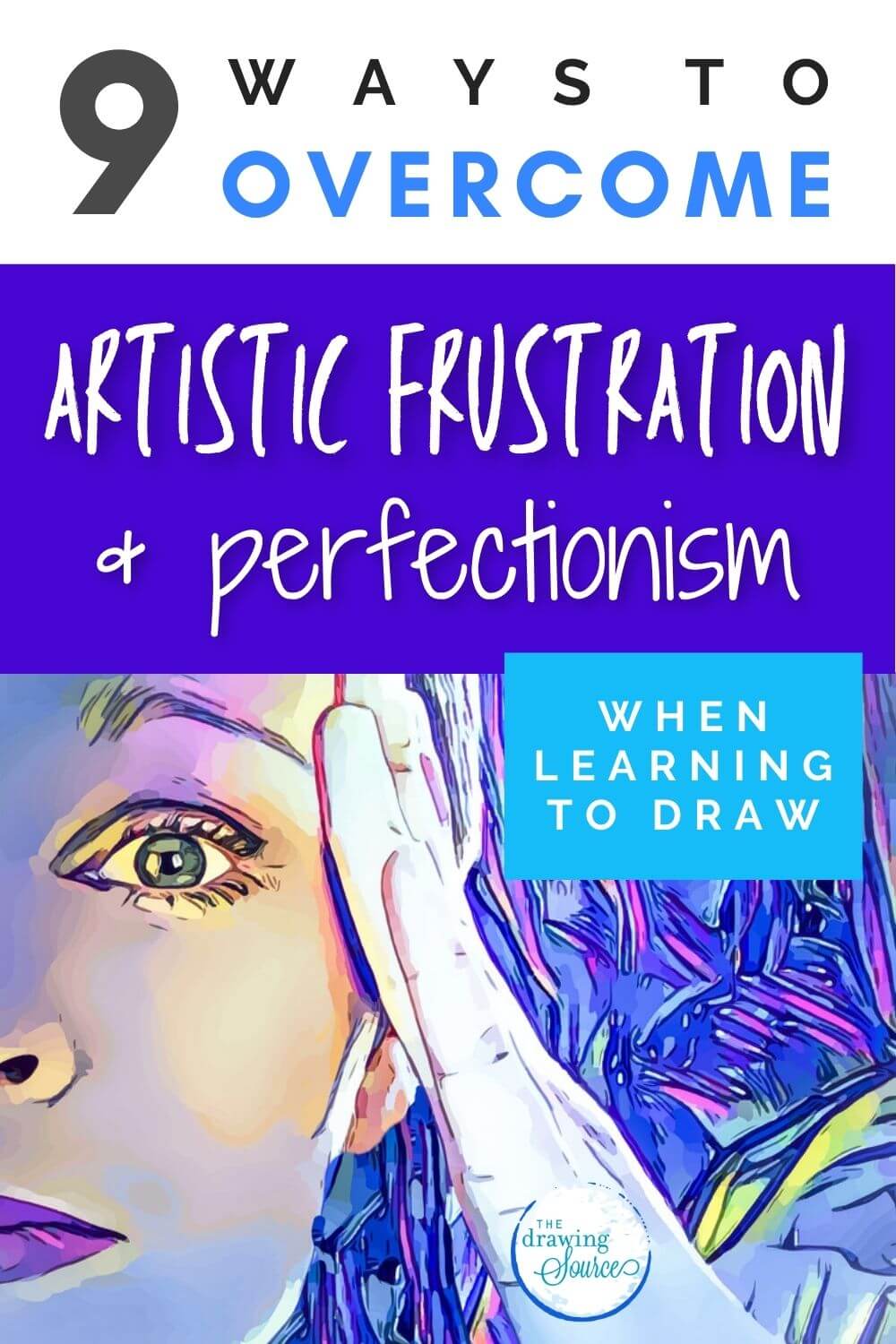
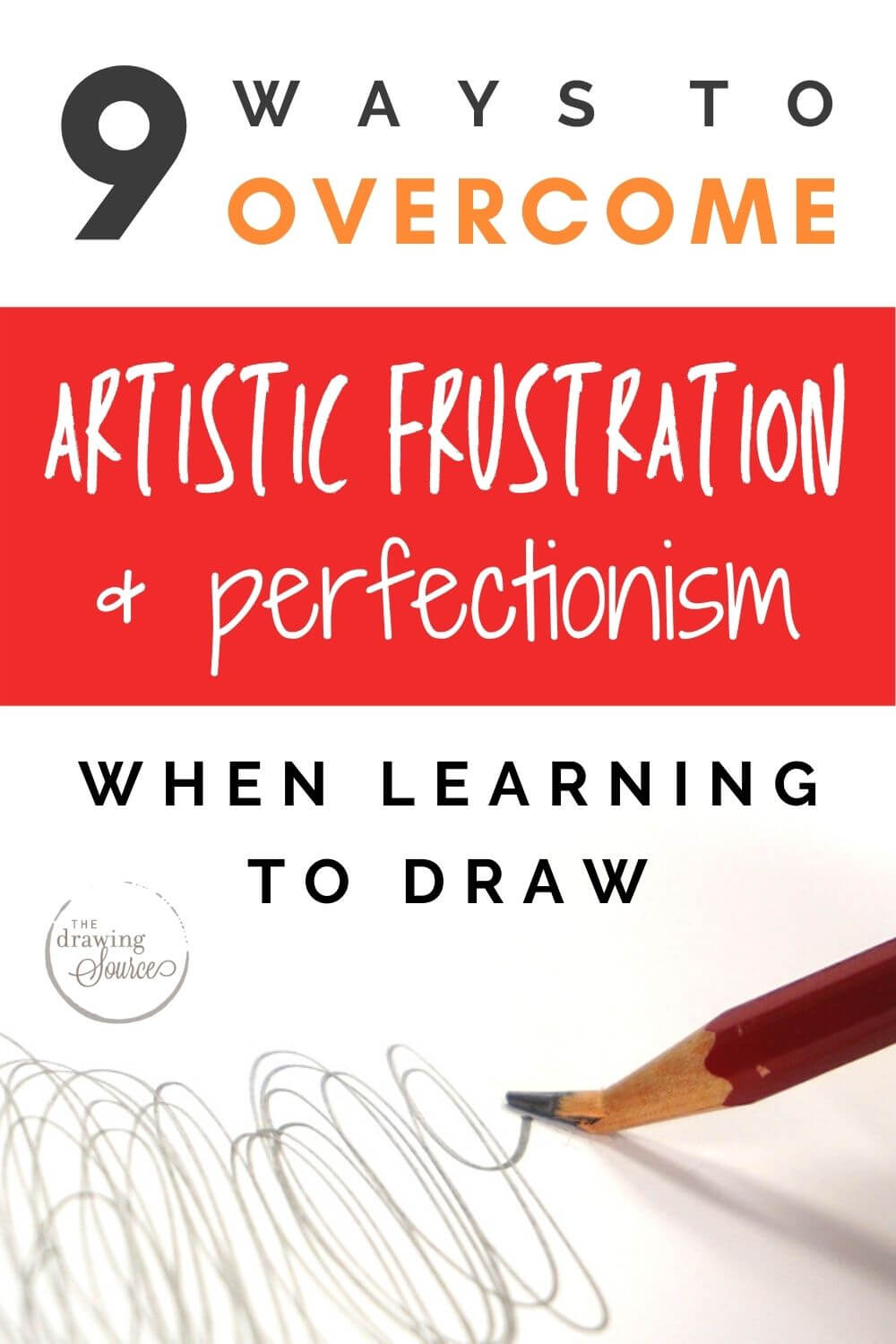
If you enjoyed this page on Overcoming Artistic Frustration & Perfectionism, you might be interest in:
Related Pages
How to Think of Unlimited Drawing Ideas
30 Ideas for Drawing (While in Isolation or Lockdown)
The Difference Between Looking and Seeing
Return to Drawing Inspiration from Overcoming Artistic Frustration & Perfectionism
Return to the Homepage from Overcoming Artistic Frustration & Perfectionism
